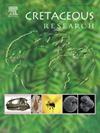来自塞尔维亚的第一具恐龙遗骸:来自奥斯马科沃白垩纪晚期(马斯特里赫特)的蜥脚类恐龙和兽脚亚目恐龙化石
IF 1.7
3区 地球科学
Q1 GEOLOGY
引用次数: 0
摘要
在几个欧洲国家的上白垩纪(坎帕尼亚-马斯特里赫特),已知有丰富多样的大陆脊椎动物组合。它们形成于一个岛屿群岛,其特点是不同寻常的地方群体和来自北美、亚洲和冈瓦纳的移民的独特组合。虽然在附近的保加利亚发现了恐龙化石,但在塞尔维亚中生代发现的大陆脊椎动物的身体化石以前是未知的。在这里,我们描述了来自塞尔维亚东南部奥斯马科沃白垩纪晚期(马斯特里赫特)的一个新的脊椎动物组合的恐龙成分。一块较大的骨头代表了蜥脚类恐龙的部分左尺骨。它的解剖结构表明它与泰坦龙有相似之处,尽管它看起来与罗马尼亚马斯特里赫特人的Magyarosaurus和Petrustitan泰坦泰坦有所不同。这个元素的小尺寸可能表明它的幼年性质,或者它代表了类似于马yarosaurus的岛屿侏儒,但区分这些可能性需要组织学工作。16颗分离的兽脚亚目恐龙牙齿,其中一些不完整,通过筛洗和比较解剖学和机器学习分析进行研究。根据这两种方法,这些牙齿中有九颗属于驰龙科。通过机器学习,三颗强烈反折且缺乏锯齿的牙齿被识别为Aves,但也可能代表动龙的前上颌牙齿,因此被称为Paraves。剩下的牙齿包括一个神秘的副爪龙标本和三个保存得太差,无法识别兽脚目以外的物种。该组合与罗马尼亚同时期的组合相似,表明在塞尔维亚中生代有进一步发现的潜力。本文章由计算机程序翻译,如有差异,请以英文原文为准。
First dinosaur remains from Serbia: Sauropod and theropod material from the uppermost Cretaceous (Maastrichtian) of Osmakovo
Diverse and abundant continental vertebrate assemblages are known from the Upper Cretaceous (Campanian–Maastrichtian) of several European countries. They formed on an island archipelago and are marked by their distinctive combination of unusual endemic groups and immigrants from North America, Asia and Gondwana. Although dinosaur fossils have been described from nearby Bulgaria, body fossils of continental vertebrates were previously unknown from the Mesozoic of Serbia. Here, we describe the dinosaurian component of a new vertebrate assemblage from the uppermost Cretaceous (Maastrichtian) of Osmakovo in southeastern Serbia. A single larger bone represents the partial left ulna of a sauropod dinosaur. Its anatomy is suggestive of titanosaurian affinities, although it appears distinct from the titanosaurs Magyarosaurus and Petrustitan from the Maastrichtian of Romania. The small size of this element may indicate its juvenile nature or that it represents an island dwarf similar to Magyarosaurus, but distinguishing these possibilities will require histological work. Sixteen isolated theropod teeth, some incomplete, were recovered by screenwashing and studied using comparative anatomy and machine learning analysis. Nine of these teeth are referred to Dromaeosauridae based on both approaches. Three teeth that are strongly recurved and lack serrations were identified as Aves by machine learning but might alternatively represent dromaeosaurid premaxillary teeth and are thus referred to Paraves. The remaining teeth comprise one specimen of the enigmatic Paronychodon and three too poorly preserved to identify beyond Theropoda. This assemblage shows similarities to contemporaneous assemblages from Romania and suggests the potential for further discoveries in the Mesozoic of Serbia.
求助全文
通过发布文献求助,成功后即可免费获取论文全文。
去求助
来源期刊

Cretaceous Research
地学-地质学
CiteScore
4.10
自引率
19.00%
发文量
235
审稿时长
12 weeks
期刊介绍:
Cretaceous Research provides a forum for the rapid publication of research on all aspects of the Cretaceous Period, including its boundaries with the Jurassic and Palaeogene. Authoritative papers reporting detailed investigations of Cretaceous stratigraphy and palaeontology, studies of regional geology, and reviews of recently published books are complemented by short communications of significant new findings.
Papers submitted to Cretaceous Research should place the research in a broad context, with emphasis placed towards our better understanding of the Cretaceous, that are therefore of interest to the diverse, international readership of the journal. Full length papers that focus solely on a local theme or area will not be accepted for publication; authors of short communications are encouraged to discuss how their findings are of relevance to the Cretaceous on a broad scale.
Research Areas include:
• Regional geology
• Stratigraphy and palaeontology
• Palaeobiology
• Palaeobiogeography
• Palaeoceanography
• Palaeoclimatology
• Evolutionary Palaeoecology
• Geochronology
• Global events.
 求助内容:
求助内容: 应助结果提醒方式:
应助结果提醒方式:


